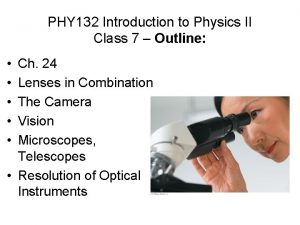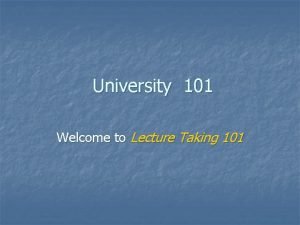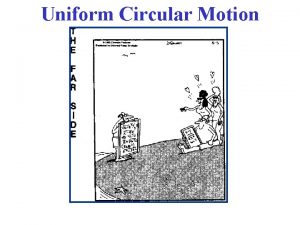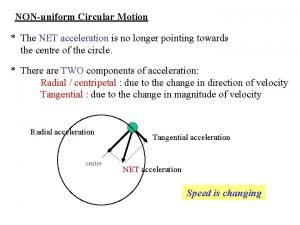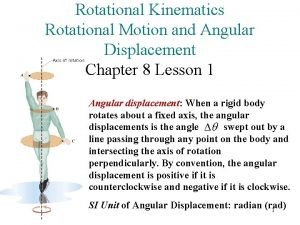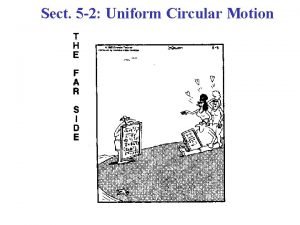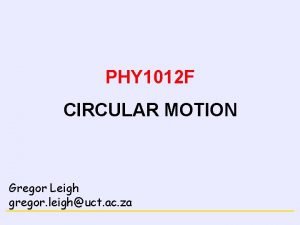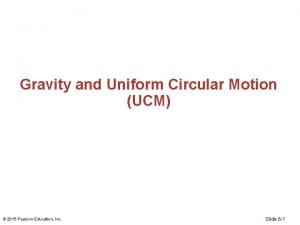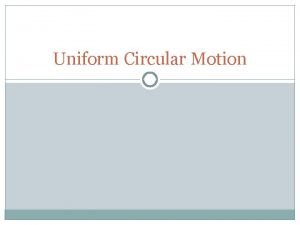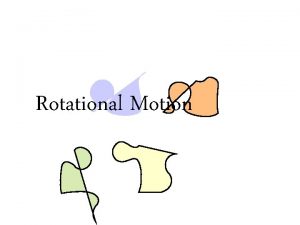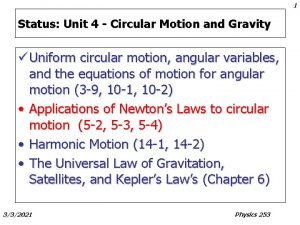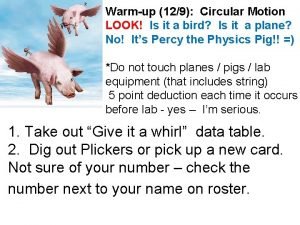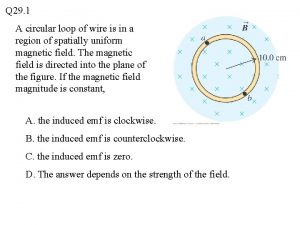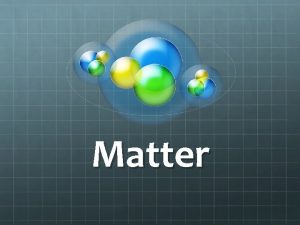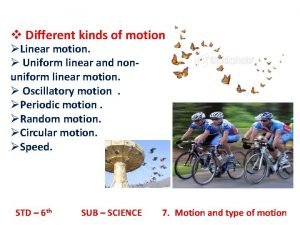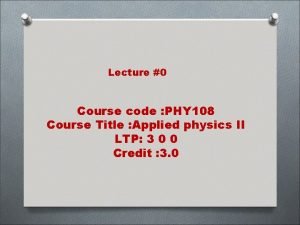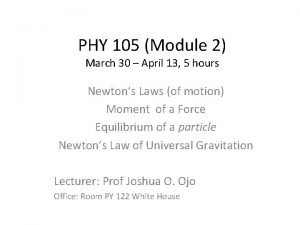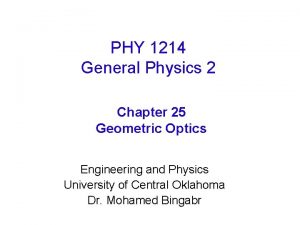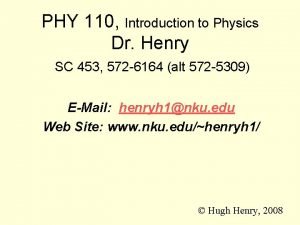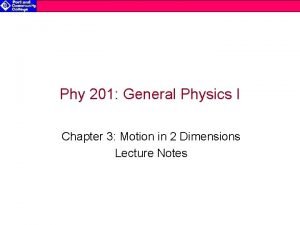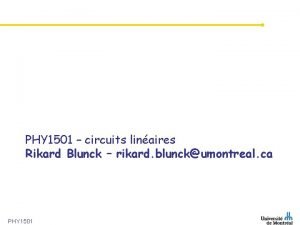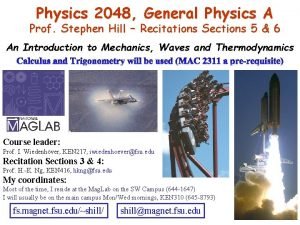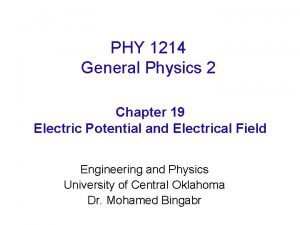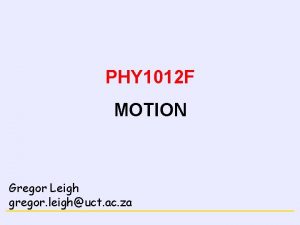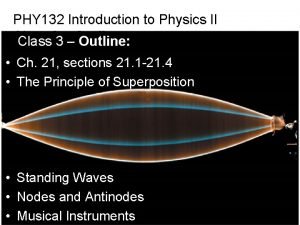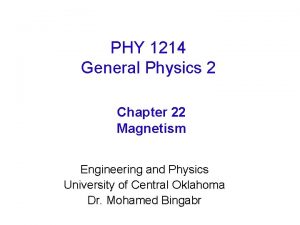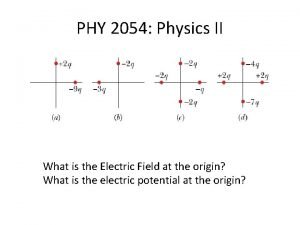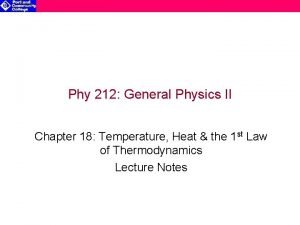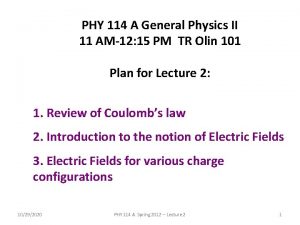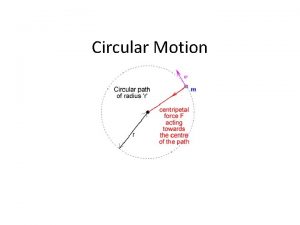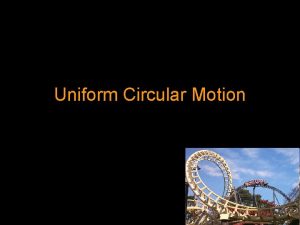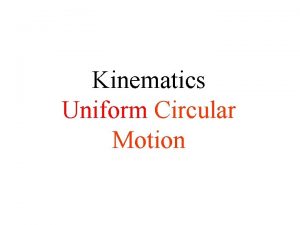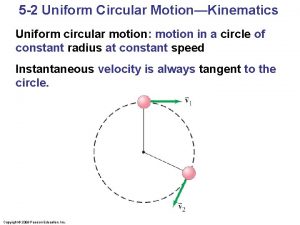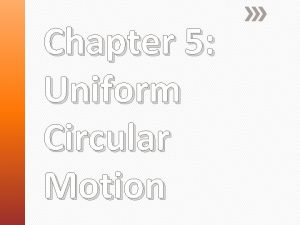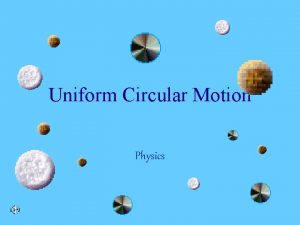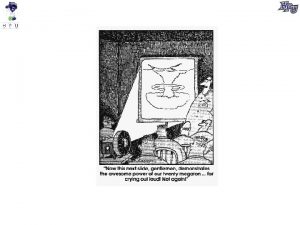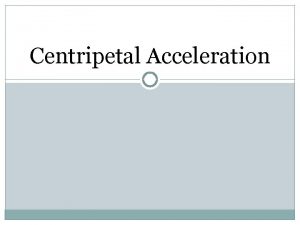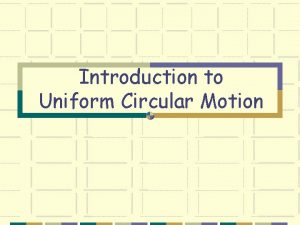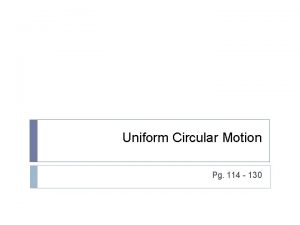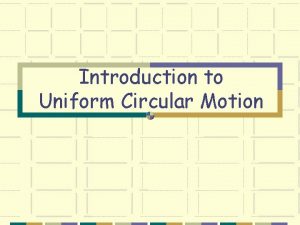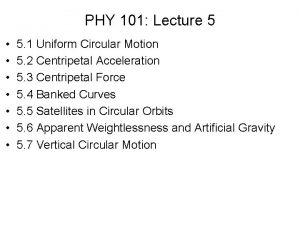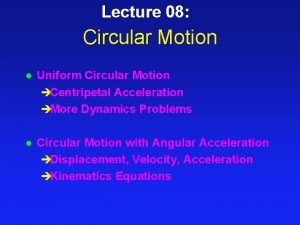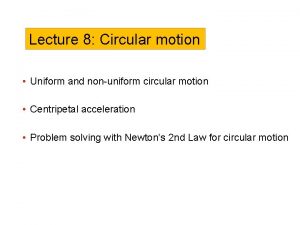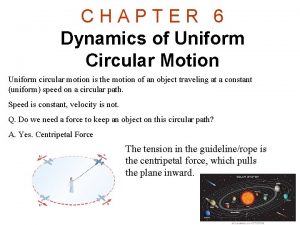PHY 101 Lecture 5 5 1 Uniform Circular















































- Slides: 47

PHY 101: Lecture 5 • • 5. 1 Uniform Circular Motion 5. 2 Centripetal Acceleration 5. 3 Centripetal Force 5. 4 Banked Curves 5. 5 Satellites in Circular Orbits 5. 6 Apparent Weightlessness and Artificial Gravity 5. 7 Vertical Circular Motion

PHY 101: Lecture 4 Dynamics of Uniform Circular Motion 5. 1 Uniform Circular Motion

Accelerated Motion • No Acceleration ØObject is at rest ØObject is moving in a straight line with constant speed • Acceleration ØObject is moving in a straight line with changing speed ØObject is moving in a curve with constant speed ØObject is moving in a curve with changing speed

Uniform Circular Motion • Uniform circular motion is the motion of an object traveling at a constant (uniform) speed on a circular path • The magnitude of the object’s velocity in circular motion is constant • Direction of the velocity changes in time

Uniform Circular Motion Period • Period (T) – Time required to travel once around the circle – Time for one revolution, one lap, or one cycle • • speed = distance / time Let v be the speed (normally v is velocity) d is the circumference of the circle, 2 pr v = d / t = 2 pr / T

Period - Example • The tangential speed of a particle on a rotating wheel is 3. 0 m/s • Particle is 0. 20 m from the axis of rotation • How long will it take for the particle to go through one revolution? Ød = vt Ø 2 pr = v. T ØT = 2 pr/v = 2 p(0. 20)/3. 0 = 0. 42 s

PHY 101: Lecture 4 Dynamics of Uniform Circular Motion 5. 2 Centripetal Acceleration

Centripetal Acceleration • Magnitude: – Centripetal acceleration of an object moving with a speed v on a circular path of radius r has a magnitude ac • ac = v 2/r = 4 p 2 r/T • Direction: – Centripetal acceleration vector points toward the center of the circle and continually changes direction as the object moves

Centripetal Acceleration – Example 1 • A racing car with a speed of 33. 3 m/s goes around a level, circular track with a radius of 1000 m • What is the centripetal acceleration of the car? Øac = v 2/r = (33. 3)2/1000 = 1. 11 m/s 2

Centripetal Acceleration - Example 2 • A car with a constant velocity of 23. 1 m/s enters a circular flat curve with a radius of curvature of 400 m • The friction between the road and the car’s tires can supply a centripetal acceleration of 1. 25 m/s 2 • Does the car negotiate the curve safely? Ø ac = v 2/r = (23. 06)2/400 = 1. 33 m/s 2 Ø Centripetal acceleration provided by friction is not enough to have the car stay on the curve

PHY 101: Lecture 4 Dynamics of Uniform Circular Motion 5. 3 Centripetal Force

Centripetal Force • Centripetal Force is name given to the net force required to keep an object of mass m, moving at velocity v, on a circular path of radius r • Magnitude: Fc = mac Fc = mv 2/r = m 4 p 2 r/T 2 = mrw 2 • Direction: – Centripetal force vector always points toward the center of the circle and continually changes direction as the object moves

Sources of Centripetal Force • What provides centripetal force depends on the physical situation ØMoon in orbit around earth – gravity ØGravitron amusement park ride – normal force ØChild spins toy on end of rope – tension ØCar making a turn on flat road - friction

Centripetal Force – Example 1 • A car is going in a circle at 30 m/s and radius 150 m • Your body’s mass is 80 kg • What centripetal force does you body feel ØFc = mv 2/r = 80(302)/150 = 480 N

Centripetal Force – Example 2 • A car of mass 1. 5 x 103 kg rounds a circular turn of radius 20 m • The road is flat and the coefficient of static friction between the tires and the road is 0. 50 • How fast can the car travel without skidding? Ø Centripetal force is provided by static friction between the tires and the road Ø Car can make the turn without skidding if the centripetal force equals the maximum static friction Ø Fc = mv 2/r Ø ms. N = ms(mg) = mv 2/r Ø v = sqrt(msgr) = sqrt(0. 50 x 9. 8 x 20) = 9. 9 m/s

Centripetal Force – Example 3 • A car goes over the top of a hill with a radius of 150 m • Mass of the driver is 80 kg • What normal force does driver feel? Ø Fc = mv 2/r Ø N - mg = -mv 2/r Ø N = mg - mv 2/r Ø N = 80(9. 8 - 302/180)=384 N At what speed is N = 0 0 = m(g-v 2/r) v = sqrt(rg) = sqrt(150 x 9. 8) v = 38. 3 m/s At this speed the car leaves the road

Centripetal Force – Example 4 • Fighter plane dives towards ground and then pulls up (Position 1 in diagram) • Velocity is 400 m/s • Turning radius is 3600 m • Mass of the pilot is 60 kg • What is normal force on pilot? Ø Fc = mv 2/r Ø Ø Ø N – mg = mv 2/r N = m(g + v 2/r) N = 60(9. 8 + 4002/3600) = 3254 N Pilots weight is mg = 60(9. 8) = 588 N N = 5. 53 times weight of pilot

Centripetal Force – Example 5 ØWhat is the slowest velocity if bike is to stay on the track at position 3? ØFc = mv 2/r Ø-N – mg = -mv 2/r ØN + mg = mv 2/r Øv = sqrt[r(N/m + g)] ØJust leave track when N = 0 Øv = sqrt(rg)

Centripetal Force - Example 6 • Plane turns • Main force is the lift of the wing • Inclining plane in turn causes lift to act as normal force • Concorde flies at 600 m/s • Passenger can’t take normal force greater than 1. 5 mg • What is sharpest turn it can make?

Centripetal Force - Example 6 Find q L = 1. 5 mg Lcosq = mg 1. 5(mg)cosq = mg cosq = 1/1. 5 = 2/3 q= 48. 190 Find r Fc = mv 2/r Lsinq = mv 2/r 1. 5(mg)sinq = mv 2/r r = v 2/1. 5 gsinq r=360000/[1. 5(9. 8)sin 48. 19]=32. 9 km

Centripetal Force – Example 7 • • Coin sits on long playing record spinning at 33. 33 rpm Coefficient of friction between penny and record is 0. 3 What is maximum r for penny to remain on the record v = 33. 33 rpm = 33. 33 x 2 pr/60 m/s =3. 49 r m/s Fc = mv 2/r ms. N = msmg = mv 2/r msg = 3. 492 r 2/r r = msg/3. 492 =0. 3(9. 8)/12. 18 = 0. 241 m

Centripetal Force – Example 8 • Circular room with a person pressed against the wall • What is ms to keep the person from sliding down? • Radius is 3 meters • Rotating at 20 revolutions/minute

Centripetal Force – Example 8 • v = 20 rpm = 20 x 2 pr/60 m/s • v = 20 rpm =2. 09(3) = 6. 28 m/s • Friction force = weight • ms. N = mg • Normal force is centripetal force • Fc = N = mv 2/r • msmv 2/r = mg • ms = gr/v 2 = (9. 8)(3)/6. 282 = 0. 76

PHY 101: Lecture 4 Dynamics of Uniform Circular Motion 5. 4 Banked Road

Centripetal Force Banked Road • Fc = FNsinq = mv 2/r • FNcosq = mg • Divide first equation by second equation • tanq = v 2/gr

Centripetal Force Banked Road - Example • A car with a velocity of 30 m/s makes a turn of radius 150 m on a banked road of angle q Calculate q Øtanq = v 2/gr = (30)2/(9. 8 x 150) = 0. 6122 Øq = 31. 470

PHY 101: Lecture 4 Dynamics of Uniform Circular Motion 5. 5 Satellites in Circular Orbits

Centripetal Force Satellites in Orbit - 1 • Satellite of mass m is in orbit around earth • Gravitational pull of earth provides centripetal force ØFc = GMem/r 2 = mv 2/r ØGMe/r = v 2 Øv = sqrt(GMe/r) • Orbital velocity for a given radius is independent of mass of satellite

Centripetal Force Satellites in Orbit - 2 • • • v = sqrt(GMe/r) (from prior slide) v = 2 pr/T (definition of period) 2 pr/T = sqrt(GMe/r) T 2 = 4 p 2 r 3/Gme r 3 = T 2 Gme/4 p 2 Relationships between period, T, and orbital radius r

Low Earth Orbit - 1 • • • Velocity of a satellite in low earth orbit Me = 5. 98 x 1024 kg re = 6. 37 x 106 m Height of satellite = 120 miles = 0. 19 x 106 m rorbit = 6. 56 x 106 m G = 6. 67 x 10 -11 nm 2/kg 2 v = sqrt(GMe/r) v = sqrt(6. 67 x 10 -11 x 5. 98 x 1024/ 6. 56 x 106) v = 7797 m/s = 17, 446 mi/hour

Low Earth Orbit - 2 • • • Period of satellite in low earth orbit T 2 = 4 p 2 r 3/Gme re = 6. 38 x 106 m Height of satellite = 120 miles = 0. 19 x 106 m rorbit = 6. 56 x 106 m me = 5. 98 x 1024 kg T 2 = 4 p 2(6. 38 x 106)3/[6. 673 x 10 -11 x 5. 98 x 1024] T 2 = 27941796 s 2 T = 5286 s = 88 minutes

Geosynchronous Orbit - 1 • A satellite in geosynchronous orbit stays above a specific place on the earth • For this to occur, the period of the orbit must be 24 hours = 86400 s • r 3 = T 2 Gme/4 p 2 • r 3 = (86400)2 x [6. 673 x 10 -11 x 5. 98 x 1024] /4 p 2 • r 3 = 7. 55 x 1022 m 3 • r = 4. 23 x 107 m = 26, 268 miles • This is distance from center of the earth

Geosynchronous Orbit - 2 • • • r = 4. 23 x 107 m = 26, 268 miles This is distance from center of the earth Radius of earth is 6. 38 x 106 m Distance from surface is 4. 23 x 107 – 0. 64 x 107 = 3. 59 x 107 m 22, 312 miles

Satellites in Orbit – Example 3 • • Earth orbits the sun as a satellite. What is sun’s mass? Distance from earth to sun, rse = 1. 5 x 1011 m Period of earth around sun Ø T = 365. 24 days x 24 x 60 = 3. 156 x 107 s • • d = vt v = d/t = 2 prse /T GMsun/rse = v 2 = 4 p 2 rse 2/T 2 Msun = 4 p 2 rse 3/GT 2 Msun = 4 p 2(1. 5 x 1011)3/6. 67 x 10 -11/(3. 156 x 107)2 Msun = 2 x 1030 kg Msun/Mearth = 2 x 1030 / 6 x 1024 = 330, 000

Satellites in Orbit – Example 4 • • • Moon is satellite of Earth Io is satellite of Jupiter What is ratio of Jupiter’s mass to earth’s mass Period, Tmoon , of the moon is 27 days Period, Tio, of Io is 1. 5 days Radii of the moon and Io are approximately the same • Mearth = 4 p 2 rme 3/GTmoon 2 • Mjupiter = 4 p 2 rij 3/GTio 2 • Mjupiter/Mearth = Tmoon 2/Tio 2 = (27/1. 5)2 = 324

Satellites in Orbit – Example 5 • • • Earth and Jupiter are satellites of the sun What is ratio of Jupiter’s period to earth’s period 1 AU = 1. 5 x 1011 m, distance from earth to sun Earth’s distance from sun is 1 AU (astronomical unit) Jupiter’s distance from sun is 5. 2 AU Msun = 4 p 2 rse 3/GTearth 2 = 4 p 2 rse 3/GMsun Tjupiter 2 = 4 p 2 rsj 3/GMsun Tjupiter/Tearth = sqrt(rsj 3/rse 3) = sqrt(5. 23/13) = 11. 86

Stars Orbiting Edge of Galaxy - 1 • Mass of galaxy is 2 x 1041 kg • This is the mass of visible stars and dust • A star orbits the galaxy at 2. 7 x 1020 m from the center of the galaxy • This is close to the edge of the galaxy • Assume 90% or more of the galactic mass is inside the star’s orbit • Find a formula for the orbital velocity of star’s at the edge of the galaxy

Stars Orbiting Edge of Galaxy - 2

Graph

Actual Data Rotation curve of a typical spiral galaxy: predicted (A) and observed (B). The discrepancy between the curves is attributed to dark matter.

PHY 101: Lecture 4 Dynamics of Uniform Circular Motion 5. 6 Apparent Weightlessness and Artificial Gravity

Apparent Weightlessness • Person is on a scale in a freely falling elevator and in a satellite in a circular orbit. When the person is standing stationary on the earth, his weight is 800 N. In each case, the scale records 0 N. • N is apparent weight • N = ma + mg • a = -9. 8, g = -9. 8 • N = m(-9. 8 – 9. 8) = 0

Artificial Gravity • A space station rotating about an axis. Because of the rotational motion, any object located at point P on the interior surface of the station experiences a centripetal force directed toward the axis. The surface of the station provides this force by pushing on the feet of an astronaut. The centripetal force can be adjusted to match the astronaut’s earth-weight by selecting the rotational speed of the space station.

Artificial Gravity - Example • At what speed must the interior surface of the space station (r = 1700 m) move, so that the astronaut experiences a push on his feet that equals his weight on earth (800 N)? • Fc = mv 2/r • Fc = mg • mg = mv 2/r • v 2 = rg • v = sqrt(rg) = sqrt (1700 x 9. 8) = 130 m/s

PHY 101: Lecture 4 Dynamics of Uniform Circular Motion 5. 7 Vertical Circular Motion

Vertical Circular Motion - 1

Vertical Circular Motion - 2 • m = mass of motorcycle and rider • At point 3 when FN 3 = 0, the motorcycle will leave the track • Then v 3 = sqrt(rg)
 Phy 132 lecture 10: ch30
Phy 132 lecture 10: ch30 01:640:244 lecture notes - lecture 15: plat, idah, farad
01:640:244 lecture notes - lecture 15: plat, idah, farad Physics 101 lecture notes pdf
Physics 101 lecture notes pdf Waves pdf download
Waves pdf download Lecture 101
Lecture 101 Phy101 lecture 1
Phy101 lecture 1 Physics 101 lecture notes pdf
Physics 101 lecture notes pdf Hair design
Hair design Dynamics of uniform circular motion
Dynamics of uniform circular motion What is uniform circular motion
What is uniform circular motion Net acceleration in circular motion
Net acceleration in circular motion Angular displacement
Angular displacement How are uniform circular motion maps
How are uniform circular motion maps Constant speed circular motion
Constant speed circular motion Non uniform circular motion
Non uniform circular motion A car turns a corner on a banked road
A car turns a corner on a banked road Uniform circular motion lab
Uniform circular motion lab Circular velocity formula
Circular velocity formula Non uniform circular motion
Non uniform circular motion Acceleration in circular motion formula
Acceleration in circular motion formula A circular loop of wire and a long straight wire
A circular loop of wire and a long straight wire How do you classify uniform and non-uniform mixtures?
How do you classify uniform and non-uniform mixtures? Homogeneous vs heterogeneous mixture
Homogeneous vs heterogeneous mixture Rumus kedalaman kritis trapesium
Rumus kedalaman kritis trapesium Type of motion
Type of motion Phy108
Phy108 Phy-105 5 discussion
Phy-105 5 discussion General physics
General physics Law of motion
Law of motion Phy 2049
Phy 2049 Phy 131 past papers
Phy 131 past papers Vx=vox+axt
Vx=vox+axt Phy1501
Phy1501 Atm basics
Atm basics Phy theorem
Phy theorem Ddr phy architecture
Ddr phy architecture Stephen hill fsu
Stephen hill fsu Phy 1214
Phy 1214 Complete motion diagram
Complete motion diagram Phy
Phy Pa msu
Pa msu Phy 132
Phy 132 Phy tgen
Phy tgen Applications of magnetism
Applications of magnetism Phy
Phy Phy 205
Phy 205 Examples of convection
Examples of convection Phy
Phy
